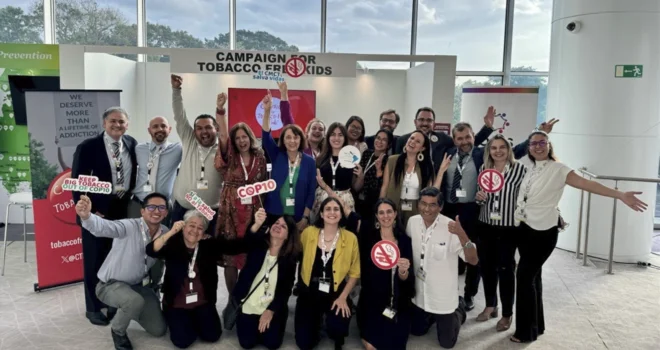Dr Rushd Fadhil Al-Shama, summarises the inspiring Panel discussion on ‘Tobacco and Youth” of which she was a speaker and moderator
My name is Rushd Fadhil Al-Shama, a medical graduate from Dubai, currently undergoing a research master in cardiovascular science in the Netherlands. I took part in a panel discussion about the tobacco issue in the youth, a topic I’m passionate about. Due to my previous work, most notably heading the organizing committee in the Tobacco and Youth full-day-event within the 5th Emirates Cardiac Society Congress in 2014, I was invited to moderate and speak in this panel held on the 5th of December in the World Congress of Cardiology and Cardiovascular Health in Dubai, UAE. The panel was designed to address the issue from a new perspective, speaking as a young individual and addressing less commonly known facets of the matter.
Starting medical school in 2011 with an interest in fighting tobacco among other issues, I took different roles as vice president of the university’s student union, medical students’ society national officer of medical education, and public health activist. I organized numerous public health campaigns and events, and pushed students to be active voices in the discussion, whether as advocates against smoking or smokers voicing their perspective. Those activities ranged from walks and health check-up stations, to school visits and presentations, to TV interviews and newspaper articles. After organizing and speaking in the Tobacco and Youth event, I also spoke about the same topic in the 16th World Conference on Tobacco or Health 2015 in Abu Dhabi, UAE. That, alongside my clinical practice and personal encounters with smokers and their relatives, and on the basis of being young myself, I developed a passionate understanding of the matter I knew I needed to share and spread. This article is to carry the message in a new perspective, though summarized, further and outside of the panel. Be ready to be troubled.
What was referred to as “coffin nails” over a 100 years ago, still continues to be the most dangerous serial killer worldwide. “Coffin nails”, a phrase used to refer to cigarettes in light of knowing its self-destructive shades, alongside other forms of tobacco, continues to be the biggest crime against humanity. It is exceeding in harm inflicted and death tolls, over 7 million per year and growing, all other crimes we so passionately take serious action against and incriminate. Unfortunately, this aggressive and longstanding epidemic starts its process in 90% of the cases, in the form of the first smoking experience, in children and adolescents under the age of 18. Many young people smoke because their friends or family do so, a rite of passage to adulthood, and to cope with stress of teenage years. But let’s not forget this, many people are rational smokers, making the knowledgable decision to smoke because they enjoy it or do not truly grasp the risks and underestimate them. Their enjoyment of the “buzz”, the mouth feel, and the fun of the activity, should be taken into consideration when addressing the issue. The youth are smoking. Imagine this with me: a 10-year-old asking you for a lighter for his cigarette. That’s the first thing that should trouble you.
At the current age of 24, I have grown in the media revolution era, understanding and undergoing influences I witness and am subject to. From that perspective, I see that I and people of my age group are constantly experiencing input from songs, music videos, movies and series, and social media influencers. This is the new form of advertising, now that explicit tobacco ads are banned in many countries. Personally, I know of several songs that contain smoking references that are made to sound cool and artistic, and often, quite frankly, do. These references could be in the form of a lighter being lit, an inhalation and blowing out of smoke, or just mentions of how smoking is linked to a positive image. For instance, a famous lyric such as “and I’m talking to myself at night, because I can’t forget, back and forth through my mind, behind a cigarette”, paints an image of the smoking thinker; one who is also hiding their emotions and bonding to this protective object with a personality, the cigarette. This is coupled with unregulated music videos where smoking is a central theme, urging many people to get their hands on a cigarette or water-pipe as soon as possible in attempt to live and create the same, seemingly enjoyable, theme. Also, social media influencers, whom most young people watch for hours every day, showcase their smoking habits and products. They are taken as role models, actively or subconsciously, by watchers, leaving the young viewers, mainly, converted to their habits. I’d like to advocate for some regulations and control on the content largely viewed on the internet in regards to tobacco. I do so while noting that of the 1.1 billion smokers alive today, tobacco will kill 500 million of them; that’s 10% of the earth’s population. That’s the second thing that should trouble you.
Re-defining the problem of addiction is an interest of mine, especially in the Arabic world. This is because there is a stigma around mental health in many countries around the globe and I want to say this in the plainest way possible: tobacco addiction is a mental illness. According to the DSM-V, tobacco use disorder is diagnosed when at least 2 points of several are fulfilled. Of the points, I’ve selected to mention 4 that are commonly disregarded by smokers. The user 1) takes tobacco longer or in larger amount that they intended, 2) is not successful to cut down, 3) needs more to achieve the effect (i.e., tolerance), and 4) feels a certain way that is relieved by using tobacco (i.e., withdrawal). It is important to note clearly that tobacco is addictive. The behavioral and pharmacologic process determining tobacco addiction are shared with those of cocaine or heroin addiction. Since nicotine causes alertness and wakefulness, tobacco addicts feel superior in their addiction to illegal drug addicts. They disregard that, in the US, tobacco will kill 17 times more people than all illegal drugs combined. And why is tobacco not illegal? Take a minute to think of how powerful the lobbying of the tobacco industry is. That’s the third thing that should trouble you.
An important aspect to smoking in the Arabic world, which I dived into in the panel, was the cultural aspect. Firstly, let’s look at female smoking. Speaking to patients, friends, and reading studies on the matter, it is concluded that female smoking is very underrepresented, and therefore, not targeted or managed, mainly in the Arabic region. This is due to the fact that there is a negative and burdening stigma, leading to fear of admitting to it in non-anonymous questioning, like clinical history taking in the hospital and clinics. They also do not view smoking the water-pipe with their husbands as a social activity as an act of smoking, but rather bonding. It is also surprising that in studies looking at pregnant women, most women who quit smoking, for the health of their unborn children, only quit cigarettes and continued smoking the water-pipe. Many women also do not consider water-pipe as smoking, which brings up to the second aspect of the cultural role. Water-pipe and medwakh are largely consumed in the Arabic world in fancy and visible lounges, advertised in a promotion to a rich and cultured Arabic atmosphere. These lounges still lack the warnings, that the law obliges on cigarette packs, which inform users of the risk in order to make an informed decision. A very large amount of smokers disregard water-pipe and medwakh use as smoking due to lack of better awareness. There is a huge misconception that the water of the water-pipe cleans the water, hence making it better. This is far from the truth, as just over an hour of water-pipe is equivalent to smoking 100 cigarettes. Medwakh, a UAE-born trend, has its own issues. Ranging from that the tobacco quality is not consistent, leading to adverse effects of bad tobacco, to the fact that most guidelines do not refer to medwakh, to the effect of smoking one puff being equivalent to 5 cigarettes while many users take 20-30 puffs a day. The final cultural aspect to tackle in the Arabic world is the culture of hospitality, which, in this case, is detrimental. Many people find it shameful to ask guests to smoke outside of their house. This is an important obstacle to smoke-free homes. Besides the influence to pick the habit, this leads to second-hand smoking health effects on the unborn babies, children, and family members. What I did not mention yet is the following: out of the 7.1 million deaths by tobacco every single year, around 1 million of them are only second-hand smokers; people who did not pick up a cigarette by choice, but died by choice of others. That’s the fourth thing that should trouble you.
We need to change and improve how we treat tobacco dependence. Accessibility to the contact and services of present smoking cessation clinics is key to proper handling of this issue. Hotlines and permanently posted contact information in schools, universities, and workplaces will bring help closer and more visible to consider, de-stigmatize getting treated, and lead to positive peer effect in the youth (it’s not uncool anymore). After attending a Tobacco Dependence Treatment workshop (TDT) in Jordan, I came to understand how to better treat tobacco addicts and tackle the issue. I posted a blog article about that experience in Global Bridges, a healthcare alliance for TDT. Consultation with TDT specialists, individualized plans, counselling, offering of appropriate medications, and follow up are elements to successful treatments. What led me to take this multiple-day TDT workshop was the conclusion that we need to be better trained and equipped to ask and counsel. This conclusion was born due to seeing improper history taking by my colleague doctors in clinical practice. There is a lack of proper shame-free questioning, knowledge of current tobacco trends, and structure to a true quantification of the magnitude of use per patient. There are 1.1 billion smokers worldwide today, 50% of them will die prematurely, and many of them won’t be assessed properly by people responsible to helping their health. That’s the fifth thing that should trouble you.
There is a lot that can still be said, and I will strive to do as much as I can in this battle. I congratulate countries like the UAE for taking the powerful “sin tax” step, and hope to witness the surely positive effects of this action of taxing tobacco products. Of the worldwide economic cost of smoking ($1,436 billion in 2012), I wonder what a fraction of this, used for progress in researches and advances in science, education, and health, would do. I could only dream of the day we, as a global nation and vocal youth, stop imagining the entity of tobacco’s face as “cool”, “manly”, “powerful”, or “independent”, but rather to see it for what it truly is, the face of horror, disease, and slow, painful death.


